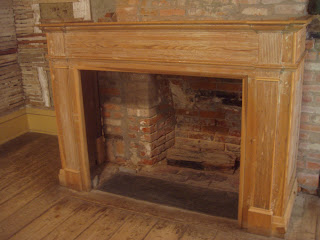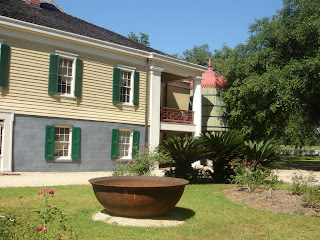Desterehan Plantation built 1790
One of the oldest homes and best-documented buildings in the Louisiana Purchase, Destrehan Plantation was constructed beginning in 1787 and completed in 1790. The owner Robin de Logny contracted with a free man of color architect & builder, Charles Pacquet, to build the house and outbuildings to support his indigo plantation. Pacquet was given the use of six slaves to build the The French colonial style house. He was paid the grand sum of "one brute negro," a cow and a calf, 100 bushels of both corn and rice, and $100 in cash upon completion. This building contract, still on file at the parish courthouse in Hahnville, LA, makes Destrehan Plantation the oldest documented house in the Lower Mississippi Valley.
Under the ownership of statesman and planter Jean Noel Destréhan, the plantation became the leading sugar producer in St. Charles Parish in 1803. Later owners included Scotsman-turned-millionaire Stephen Henderson and Judge Pierre Adolph Rost, who served on the Louisiana Supreme Court from 1845 to 1853. The plantation remained in the family until 1910.
Destrehan Plantation House represents three major phases of construction and illustrates the changes in architectural style in Louisiana. Erected in 1787 by Charles Paquet, Destrehan Plantation was purchased by indigo planter Robert Antointe Robin DeLogny and his family. Besides his profitable indigo cash crop, DeLogny's local claim to fame was his famous son-in-law, Jean Noel Destrehan, who married his daughter Marie-Claude in 1786. Destrehan was the son of Jean Baptiste Destrehan de Tours, royal treasurer of the French colony of Louisiana, and it is from him that both the name of the plantation and the name of the town are derived. After DeLogny's death in 1792, the Destrehans inherited the plantation and house.
While under the ownership of the Destrehan family, both the house and grounds went through considerable periods of change. In the 19th century the major cash crop at Destrehan became sugarcane rather than indigo and the house went through two further phases of construction. The original turned-wood cigar post gallery columns were replaced in the 1830s or 40s with massive Greek Revival Doric columns of plastered brick and the cornice was altered accordingly. Its original colonial appearance was altered with the post-colonial addition of semi-detached wings.
The dinning room
Louisiana made Creole-style tea table
The Hall
The staircase
Louisiana made Creole-style armoire with beehive turned legs
A Very Fine American Cherrywood Two-Door Armoire in the Louis XV Style, early 19th c., Louisiana.
One of the original 18th century Creole cypress wraparound mantels
Destrehan Plantation is one of the few plantations that had a indoor bathroom. The marble bathtub was giving to the family by Napoléon Bonaparte for the family's help with the Louisiana purchase
Destrehan Plantation is one of the few plantations that had a indoor bathroom. The marble bathtub was giving to the family by Napoléon Bonaparte for the family's help with the Louisiana purchase
Master bedroom
Carved bed made by a New Orleans cabinetmaker that was a Creole Free-man-of-color
Parlor
1820's Creole mantel
Creole cottage and overseers house early 19th century
Back of plantation


























































I am assuming the lovely verandas, lack of carpets and thick curtains etc were to reduce the heat and to trap any breezes. It really was an unfussy, understated and very refined architectural style and decorative style.
ReplyDeleteYes you are right! Louisiana is a very hot humid place. The wrap around wide verandas shielded the walls from the sun and heat. During the hot months windows and doors were open just about all the time to create cross ventilation. Mosquito netting on the bed protected you from biting critters. Some of the furniture in the home was cane to allow air flow. Carpets were not very popular in Louisiana they fell apart in the heat and Humidity and were only place down in the Winter months, cool grass matting were used the rest of the year.
ReplyDelete